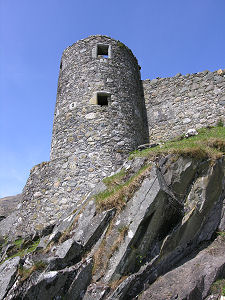 Kilchurn Castle from the Jetty |
Many Scottish castles tell the story of the changing times they lived through. It is quite common to find a castle that started life as a stronghold before being converted over the years to first a comfortable, then a showcase, home: or which was abandoned in favour of a nearby fine house when the struggle of conversion became too much trouble, and defence was no longer a priority.
Kilchurn Castle evolved in a slightly different way. It was built in about 1450 by Sir Colin Campbell, first Lord of Glenorchy, and it started life as a five storey tower house with a courtyard defended by an outer wall. By about 1500 an additional range and a hall had been added to the south side of the castle. Further buildings went up during the 1500s and 1600s.
Not often appreciated today is that when built, Kilchurn was on a small island in Loch Awe scarcely larger than the castle itself. Most sources suggest it was accessed via an underwater or low lying causeway: you only have to look at the castle today to see that when water levels were lowered by clearance of the loch's outflow in 1817, they didn't drop by far.
Kilchurn's development started to take an unusual turn in 1681. In that year, Sir John Campbell of Glenorchy was made first Earl of Breadalbane. His aim by 1689 was to take advantage of the turbulence that saw William and Mary become joint sovereigns (see our Historical Timeline). To this end he spent much of the 1690s converting Kilchurn Castle into a modern barracks capable of housing 200 troops. This saw the addition of a three storey L-shaped block along the north side of the castle.
By 1698 the Government had begun to convert Fort William into a stone fort from the wooden structure that had been placed at the head of Loch Linnhe in 1690. Whatever Sir John Campbell's real intentions in converting Kilchurn Castle, they were overtaken by the establishment of Fort William.
The Castle was used as a Government garrison during the 1715 and 1745 Jacobite Rebellions: but the family's efforts to sell it to the Government were unsuccessful. They left in 1740 and moved to Taymouth Castle in eastern Scotland, to spend their time developing their Perthshire estates. In 1760 the castle was badly damaged by lightning and was completely abandoned. It is now in the care of Historic Environment Scotland.
Kilchurn Castle can be is accessed on foot from the side of the A85 a quarter of a mile north-west of its junction with the A819. A steep descent leads to an informal parking area. In 2003 a problem arose with the long established landward access from this side because it relied on a private level crossing over the railway track. This was eventually resolved by the construction of a gravel diversion path that takes visitors towards and then alongside the River Orchy, and under the bridge that carries the railway over the river, thus avoiding the level crossing altogether.
The castle is possibly best appreciated by walking around the headland on which it stands. It looks very different from different angles, and the barracks are in stark contrast to the medieval feel of the tower on the south side. Internally you can appreciate much of the castle, though access to the viewpoint at the top of the main tower involves some unusually tight and steep steps and a narrow squeeze round a corner.
Possibly the most spectacular feature found within the castle is the top of a tower struck by lightning in 1760. Unless you know what you are looking at this can be mistaken for a stepped circular podium in the grassy courtyard: an odd feature but not a remarkable one. What you are actually looking at is the top of a corbelled-out circular tower, blown completely off its base by a lightning strike. The top of the tower landed in one piece, upside-down in the castle courtyard. The photo below shows the top of the tower, but only be seeing it for real can you begin to appreciate the ferocious amount of power that must have been needed to move to its present location.
 The Castle Courtyard |

|
|
|
Visitor InformationView Location on MapGrid Ref: NN 133 276 www.historicenvironment.scot HES: Castle Web Page The castle can be accessed on foot from the Dalmally roadside (A85) under the nearby railway viaduct. This is via the riverside, which can flood periodically, so caution is advised. What3Words Location: ///acting.processes.trend |
 Seen from the Headland Seen from the Headland |
 Attacker's Eye
View Attacker's Eye
View |
 South Side of the
Castle South Side of the
Castle |
 ...And from the South |




